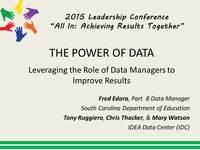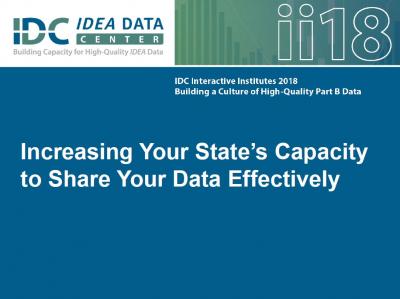Site Search
Results 1 - 7 of 9
Format: Presentations
The Power of Data: Leveraging the Role of Data Managers to improve ResultsThis session examined the strategic role data play in state agency decision making by exploring how data managers can more effectively use their role to promote public reporting, data awareness, data utilization, and systems change. Presenters paid particular attention to data governance, cross-department information sharing, timely data access, distribution, usability, and analysis, along with examples of best practice from practitioners in the field to ultimately improve student results.
Format: Toolkits
SEA Data Processes ToolkitUsing the SEA Data Processes Toolkit to document data processes for all 616 and 618 data collections will establish a well-managed process for data collection, validation, and submission. In collaboration with IDC State Liaisons, states can use the toolkit to create and maintain a culture of high-quality data and establish and support consistent practices that produce valid and reliable data, while building the capacity of state staff.
Format: Presentations
Beyond Data Submissions: Communicating Your Data to StakeholdersThis session focused on how to best communicate high-quality data by applying different strategies to prepare data for dissemination and use. Topics covered in this session included the importance of understanding the audience, how stakeholder needs can vary when understanding and interpreting data, why data governance is a key component in planning data communication activities, and why accessibility is important. This session highlighted sections of the Data Use component of the IDEA Data Center Part B Data System Framework.
Format: Presentations
Increasing Your State’s Capacity to Share Your Data EffectivelyIn this workshop, states set the stage by telling a story of how they engage stakeholders using data visualization techniques for effective communication. Session presenters introduced the IDC Part B Indicator Data Display Wizard to help states create data displays quickly and easily using SPP/APR data. In an interactive activity, participants discussed their current experiences with data use and communication and how the IDC Part B Indicator Data Display Wizard can help them create or improve a state’s current data visualization and communication process.
Format: Applications and Spreadsheets
Part B Indicator Data Display WizardThe IDC Part B Indicator Data Display Wizard helps state education agency (SEA) staff communicate complex data to stakeholders in a more user-friendly manner. This tool is designed to create data visualizations, in the form of charts, based on State Performance Plan/Annual Performance Report (SPP/APR) data the user enters. IDC has updated the tool to make it easier for users to create visualizations based on the charts’ purposes. Many of the visualizations are dynamic and automatically update based on the data the user enters into the tool. States can easily transfer the visualizations to other programs to meet their reporting needs based on the audience, message, and purpose of the desired report or presentation they are preparing.
Format: Applications and Spreadsheets
Business Rules Documentation ProtocolThe Business Rules Documentation Protocol is a customizable Excel template that states can use for documenting, recording, and communicating existing business rules or data quality validation checks they perform during the collection and validation of IDEA Part B data.
Format: Toolkits and Templates
Part C Indicator Data Display WizardThis Version 2.0 of the Data Display Wizard creates data displays based on user entry of SPP/APR data. The tool gives users various options for displaying that data. LA staff can use this tool to engage with various stakeholders on how to best display reported SPP/APR data based on the audience, message, and purpose of the desired report or presentation.








